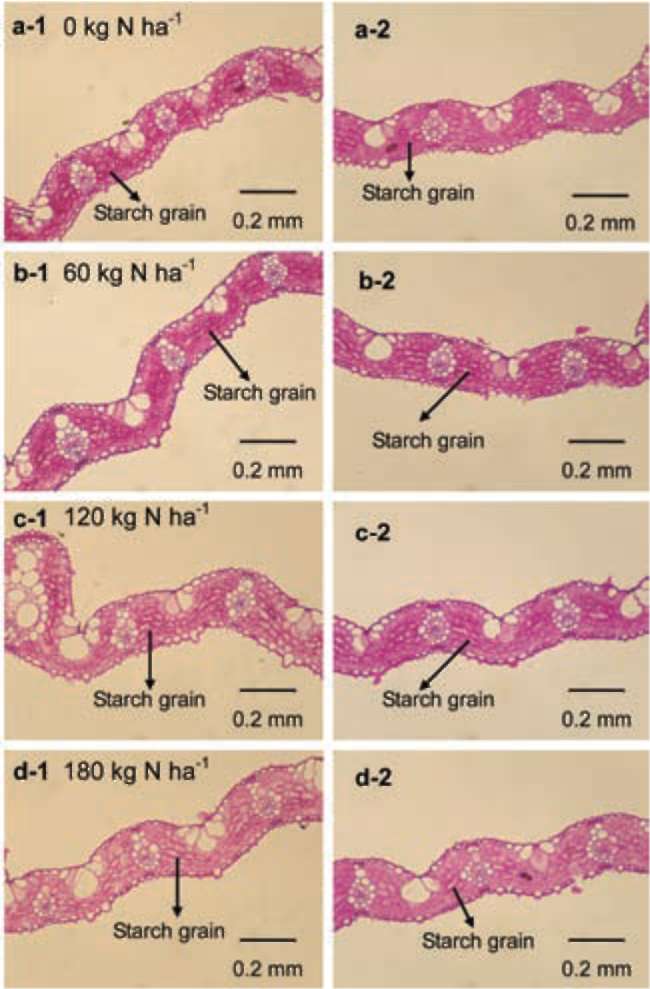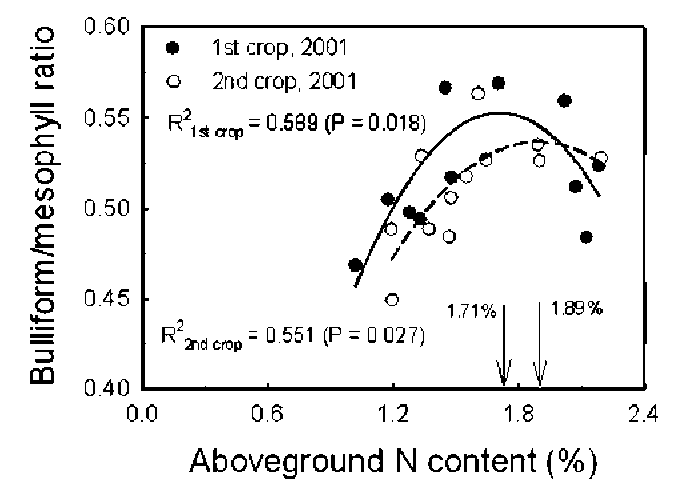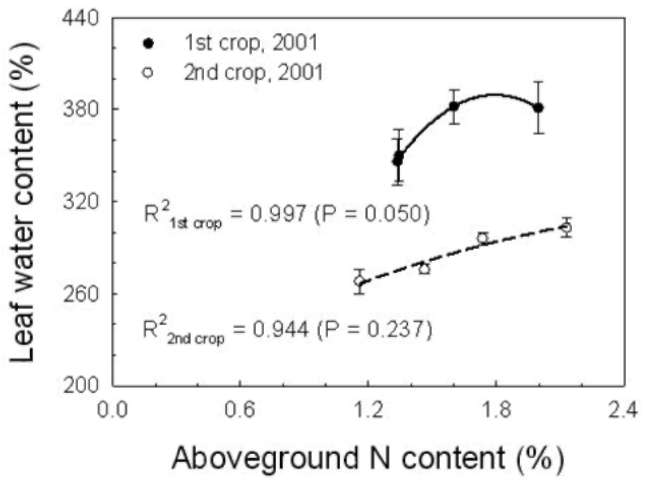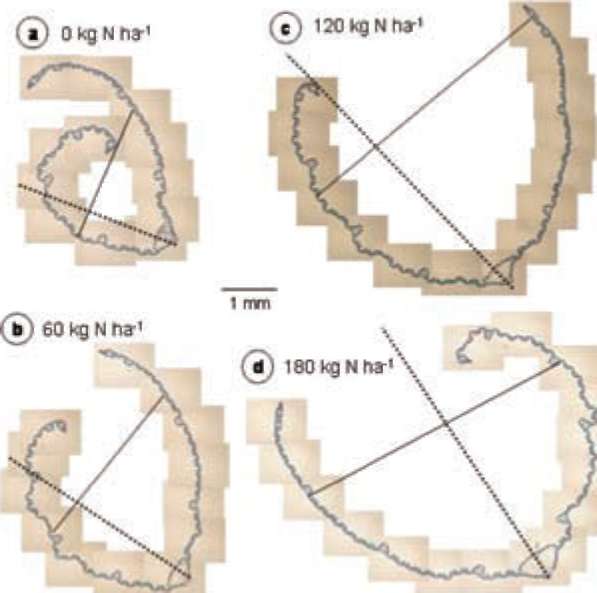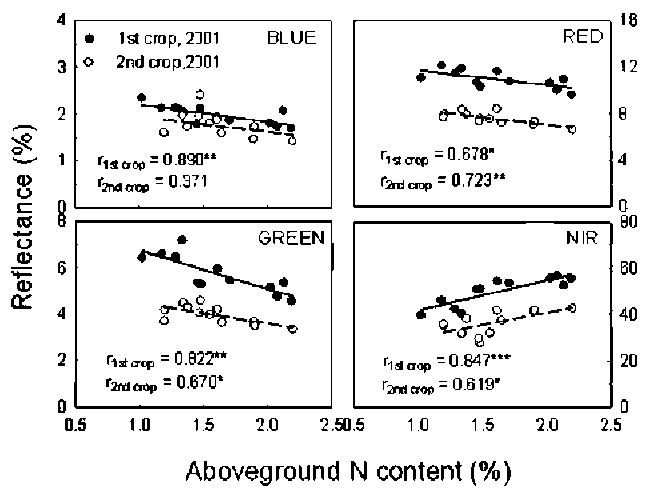LEE et al. ― Rice canopy reflectance and nitrogen status
297
(LWC; %) was calculated as:
LWC = [(FW - DW)/DW] x 100 (1)
where FW and DW were fresh weight and dry weight of the sampled leaves, respectively.
Another three mounds of each treatment were sampled at the same targeted regions the following morning, to minimize dehydration of the dissected tissue and the diurnal swelling/shrinkage cycle (McBurney, 1992). For determining leaf anatomical characteristics, six 10 mm long segments were cut consecutively 100 mm away from the apex of the upper-most fully expanded leaf blades on the main culms, were immediately fixed in FAA solution (formaldehyde: acetic acid:70% ethanol = 5:5:90, v/v/v) (Sass, 1958), then dehydrated in a TBA (tertiary butyl alcohol) series. The completely-dehydrated segments were immersed into paraffin in a 60-62°C oven. The process of paraffin infiltration was done three to four times before embedding samples with a paraffin dispenser (Lecia EG 1120, Leica Microsystems Nussloch GmbH, Germany). Cross-sections of 10 [im thick prepared from a rotary microtome (Leica RM 2135) were stained with 1% safranin-fast green, for discriminating internal leaf structure. For differentiating starch granules, PAS (periodic acid-Schiff's reaction for carbohydrates) (Jensen, 1962) was also applied. The slides were mounted in balsamo resin (ASSIS-TENT-Histokitt, Hecht Assistant Company, Germany).
Photographs of the tissue samples were taken under a light microscope (New Vanox-S AH-2, Olympus Corp., Japan) operated at magnifications of 150, 300, and 600 X using a digital camera (E5400, Nikon Corp., Japan). Micrographs were analyzed with the image analysis software SimplePCI (Compix Inc., Imaging Systems, USA) and the desired anatomical leaf characteristics, including leaf width, leaf thickness, bulliform cells and the mesophyll layer, were identified and quantified for comparison with aerial N content and canopy reflectance. Leaf thickness was measured from the traversed distance across the leaf blade mesophyll, and values from more than twelve locations along the mesophyll layer of each segment were averaged, using the mean of three replicates as representative. The leaf rolling index (LRI) was determined by dividing the distance of the cross axis perpendicular to the axis of the rolling leaf midrib to the width of leaf section, where 0 < LRI < 1 (1 = flat leaf), and was used as an indicator of the magnitude of leaf rolling after dissection. The size of bulliform cells was determined by first hand drawing boundaries around each cell then computed using the SimplePCI "Area" function. The size ratio of bul-liform cells to mesophyll (bulliform/mesophyll ratio) was computed for plants treated with different N rates, and was used to represent leaf movement strength (Buleon et al., 1998); a large ratio represents stronger leaf movement.
In Experiment II, rice from four mounds was sampled at the panicle initiation stage from each of three targeted treatment regions. This occurred on 2 May 2003 for the first cropping season and on 25 September 2003 for the second cropping season. The leaf chlorophyll content
was then determined by the modified method of Lee et al.
(2002).
Statistical analyses
The graphs were plotted using SigmaPlot 8.0.2 (SPSS ASC BV, The Netherlands). All variables were determined and averaged in each replicate. The mean and standard error of three replicates were calculated. The correlation coefficient (r) between the measured aerial N content and the amount of N fertilizer applied was computed. In correlation analysis for N effect evaluation, coefficient of determination (R2) between the measured anatomical leaf characteristics and band reflectance to aerial N or chlorophyll content was calculated.
RESULTS
Nitrogen content of aerial plant portions at the panicle initiation stage increased linearly with increasing N application rates (Figure 1). The values increased more rapidly in plants grown during the second cropping season than in those grown during the first cropping season.
Anatomical characteristics of leaf blade cross-sections are shown (Figure 2). The mesophyll layer of leaf blades from the upper-most fully expanded leaves were primarily composed of folded parenchyma cells, which were densely packed with chloroplasts giving the dark blue appearance when stained with 1% safranin-fast green. Vascular bundles were arranged parallel to each other throughout the leaf, where the xylem, phloem and bundle sheath of the vascular system were recognized. Bulliform cells, also called motor cells, were located between vascular bundles and at the bottom of the furrows of the upper epidermal surface. Starch granules were more loosely distributed and packed in the parenchyma cells in plants with higher N content (Figure 3).

Figure 1. Changes in aerial nitrogen content to the application rates of nitrogen fertilizer for rice plants (Oryza sativa L. cv. Tainung 67) grown in the first and the second cropping seasons of2001.
